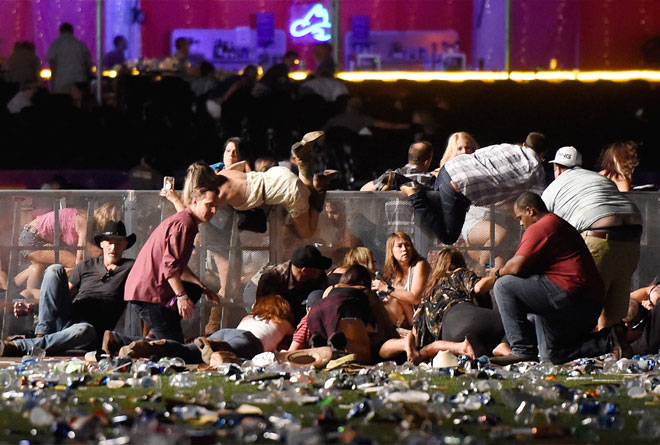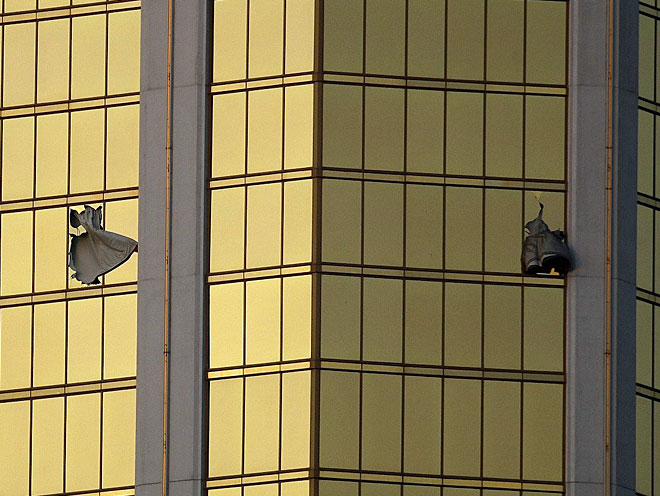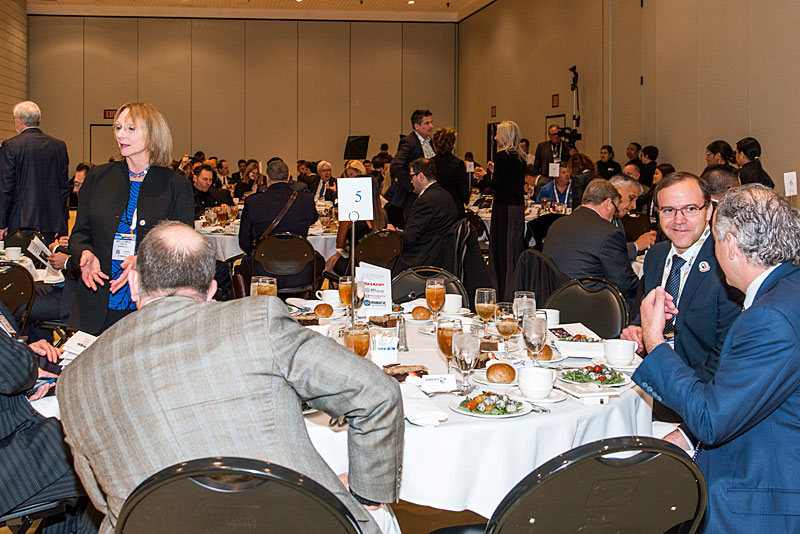Op-Ed By Doug Haines, MPSE, Owner and CEO of Haines Security Solutions
“In Las Vegas, the casino is always watching — and yet it missed XXXXXXX XXXXXXX (the title had the shooter’s name but I refused to acknowledge this scumbag),” that was the headline I read today from the LA Times.
The headline and article suggest that even though Las Vegas is a miniature surveillance state, Mr. Scumbag’s behavior somehow should have set off alarms bells and hotel security could have intervened and prevented the unfortunate events of 1 October from occurring.
Unfortunately, nothing could be further from the truth.
Let me explain.
The reporters of the article, and many people of the public, are assuming that closed circuit television cameras mounted in the lobbies and other gathering places within the hotel, near elevators, game table etc. would have caught Mr. Scumbag’s, what now seems to be bizarre behavior and someone monitoring the cameras would have noticed it to be suspicious.
The reality is nothing he did was suspicious.
He brought in his weapons hidden in suitcases just like so many guests everyday bring their suitcases, golf clubs or other oversized bags into the hotel, check-in and take them to their rooms.
Even if he had brought in all ten suitcases/bags at one time, it still wouldn’t have drawn attention.
(Learn More. Courtesy of Hot Trends 24H and YouTube. Posted on Oct 12, 2017)
How many “eccentric” guests bring a boat load of suitcases, leashed dogs and a whole entourage of stragglers?
Especially those labeled as “high rollers” or those enjoying VIP status, as was the case of Mr. Scumbag.
This is normal behavior in Las Vegas. In fact, we actually have come to expect it.
If they didn’t arrive in the Rolls and didn’t act as if they were better than everyone else we would think that to be peculiar and maybe it would sound an alarm for someone.
GIVE THE SECURITY OFFICE CREDIT – THE CCTV SYSTEM WAS EFFECTIVE
Another key misconception here is what the true purpose of CCTV is.
Most untrained folks and many within the security industry too, believe CCTV is a detection tool.

The reality is it isn’t.
It’s an assessment tool.
The camera doesn’t “detect” anything.
It captures all behavior both good and bad.
Just like your eye. It sees what it sees.
You have to decide or assess if what you see is “good” or “bad”.
The same for CCTV, it sees what it sees, then it’s up to someone else to monitor what is being seen to distinguish what is wanted or unwanted and react to the “unwanted”.
Luckily, there are camera systems currently available on the market that are very sophisticated and do a very good job with their analytics to assist the person watching the monitor with this assessment.
There are also some predictive software analytics that can watch the field of view and say, “Since the guy’s dressed like a Ninja, chances are he’s gonna pull out a sword”.
These are assessment tools and they have to be treated that way.
(An excellent example of coordinated analytics, is the DHS S&T Advanced Research Projects Agency (HSARPA) Explosives Division (EXD) Surface Transportation Explosives Threat Detection (STETD) Program, working to provide a layered, integrated capability to detect and mitigate explosive threats for the surface transportation end-user community at the speed of the traveling public. Courtesy of DHS Science and Technology Directorate and YouTube)
However, the real value of CCTV is its ability to go back in time. For that reason, they’re a great tool for evidentiary purposes.
So, in reality the CCTV did exactly as planned, it captured the behavior of guests as they moved through the hotel and allowed investigators to go back in time and fit the pieces of the “what happened” puzzle together.
BREAKING IN OR BREAKING OUT

I heard an interview with one of the concert goers and he said the security for the event was so tight and the security fencing so good that it would have been impossible for someone to get in without a ticket.
Well, the fencing needs prevent people from breaking in but it also needs to allow people to break out – similar to a panic bar on a fire door. Just saying.
RISK MANAGEMENT
Security is about risk management. It’s important to understand there are no guarantees.
So first, you have to accept the fact that you cannot stop every threat natural or man-made. Some you can and some you can’t.
There are a variety of reasons for this; not enough personnel or monetary resources are two of the most common.
Also, maybe the threat’s tactics are too common place, like using a vehicle to run over pedestrians or wielding a knife at the police.
What are we going to do, lock up all the vehicles and knives? I don’t think so.
Secondly, solutions must be in place before the event occurs.
So, usually those events (hazards) that are most likely to occur are dealt with and those that aren’t – aren’t.
That said, the fact is some things just can’t be completely prevented no matter how many resources you dedicate to them.
As a planner, you try to reduce vulnerabilities to the point that they can be contained or at least when they are exploited and compromised the effects aren’t so bad.
Anyone who suggests that the event planners should have anticipated a “guest” shooting out of a hotel window overlooking the concert grounds and could have prevented it is “off their rocker”.

I’ve sat in lots of event planning meetings where different threat scenarios are discussed and in any one of them, if someone had suggested that a person over the course of five days would bring ten guns into a hotel room and after gambling millions of dollars, would knock out a hotel room window with a hammer and start shooting people, we would have laugh at him or her, maybe even thrown an empty coffee cup or something, and moved on to a more likely threat scenario.
An assassin on a hotel roof trying to kill a political or “high profile” VIP maybe but a guy bringing automatic weapons into the hotel, breaking out a window and shooting people – well frankly, it’s very unlikely.
There are far too many more likely scenarios.
That said, I think this event and those in London, Berlin, Barcelona and elsewhere should make event planners and security officials all over the world pause for a second and realize that threat scenarios no longer fit neatly into the box like they’re supposed to.
We need to start thinking about scenarios that, albeit may seem far-fetched, are possible.
I did a presentation a couple years back at ISC-East and talked about low probability – high impact events and the need to address them.
I called dealing with them, “Impact Centric Planning.”
Many in the audience thought I was nuts. Maybe I was before my time – I don’t know. I think today what I spoke about then is much more relevant than in years past.
Instead of thinking it “won’t happen here” we need to think “It won’t happen here BUT if it does how catastrophic will it be – how many injured or deaths will there be and what kind I do now to contain it?”
CHANGE IN TRAINING
The LA Times article went on to say, that casino staff will need to be retrained.
I have a feeling this training won’t really do very much good to stop this type of event again.

Well, it’s highly unlikely it will happen again anyway under the same circumstances.
You know, lightening doesn’t strike twice in the same spot.
That’s really because the “spot” doesn’t exist anymore, it’s been vaporized by the lightening but moving on.
Some security folks will come in and tell the staff that these are the tail-tail signs of suspicious behaviors and what to look for.
And everyone will laud the training and go back to their busy schedules.
Unless, the classroom training involves regular unannounced drills afterwards what was learned will soon be forgotten, especially as folk’s transition in and out of employment.
While training is a good thing a much more permanent and effective solution would be to redesign the inhabited portions of the building so opportunities for the types of behavior witnessed in this case are reduced.
INTEGRATING PHYSICAL SECURITY INTO BUILDING DESIGN
I don’t believe in ambulance chasing nor do I believe in armchair quarterbacking.
That said, this “active shooter” event could not have been prevented as the space is currently designed.
Fortunately, there are technologies that could be implemented now that would keep a future event from being as bad as it was or at best, stopped it almost as quickly as it started.
We teach that the first mitigation strategy for line-of-sight weapons (weapons that the user must be able to see the target to engage it) is to remove the lines-of-sight.
In other words, take away the vantage points or high ground.
That’s kind of hard to do for a 90 story building but an option could be to modify the building envelop with laminated glass windows.
I don’t know for certain but I imagine the windows of the hotel rooms are tempered class instead of laminated glass.
Laminated glass would have required the shooter to repeatedly shoot at it to break it. This might have been enough but probably not if this was the only solution in place.
There is technology that exists that can “hear” gun shots.
(Learn More. Courtesy of Louroe Electronics and YouTube)
If it had been installed it would have automatically notified the security office about the exact location that the shots were coming from and even notified guest and staff on what to do (shelter-in-place or seek cover).
Coupled with the laminated glass it might have been enough.
Another option would be to create and install an explosion screen on the outside of the building (a geotextile curtain if you will) so that when the projectile hits it, it either detonates or is stopped.
The image of a big curtain hanging off the side of a luxury hotel may be a bit much for most folks.
A more practical solution could be to plant large trees along the perimeter or a covering (geotextile fabric) of some sort over the top of the concert area or a combination of both to shield the lines-of-sight.
It would be expensive but so are the law suits that are coming.
We need to start thinking about using building design to our advantage for security and not just for aesthetics or as an afterthought.
2017 ‘ASTORS’ Homeland Security Awards Recognition
Doug Haines, owner and CEO of Haines Security Solutions has been recognized for ‘Excellence in Homeland Security’ in the 2017 ‘ASTORS’ Homeland Security Awards Program at ISC East, which was held in the Jacob Javits Convention Center on November 15th.

American Security Today’s comprehensive Homeland Security Awards Program was organized to recognize the most distinguished vendors of Physical, IT, Port Security, Law Enforcement, and First Responders, in acknowledgment of their outstanding efforts to ‘Keep our Nation Secure, One City at a Time.’
Additionally, Haines Security Solutions Physical Security Engineering Training & Certification, took the Platinum ‘ASTORS’ Award Winner for Best Homeland Security Education.
Doug is a United States Air Force Veteran with over 45 years of Law Enforcement and Security Related Experience, and a Subject Matter Expert in Building Design Principles for Architects, Engineers, Facility Managers, Planners and Security Professionals.

Doug, along with David Haines, were joined by over 100 Top Government Officials and Industry Leading Firms from across North America and the Middle East in acknowledgment of their Outstanding Product Development Achievements and Exciting New Technologies to address the evolving homeland security threats our Nation is facing.
Doug has also been named the 2016 Sandy Jones Volunteer of the Year by the Security Industry Association (SIA) for his significant contributions to the security industry.
Haines Security Solutions (HSS) specializes in conducting quantitative risk and vulnerability assessments of federal, state and local facilities worldwide and other security related consulting services.
HSS also develops security criteria, conducts entry control point and security forces manpower studies, drinking water systems and critical energy infrastructure risk/vulnerability assessments, and develops, plans and conducts table-top and full scale antiterrorism, force-on-force, emergency response and disaster preparedness exercises.
Congratulations to Doug and Haines Security Solutions on your achievements and your exemplary service to our Nation.
We appreciate your informative guest editorials to educate and inform our readers, and applaud your continuing efforts in expanding Infrastructure Risk and Vulnerability Strategies into Building Design Principles in the public space.
(Learn More about Haines Security Solutions capabilities. Courtesy of Haines Security and YouTube)















